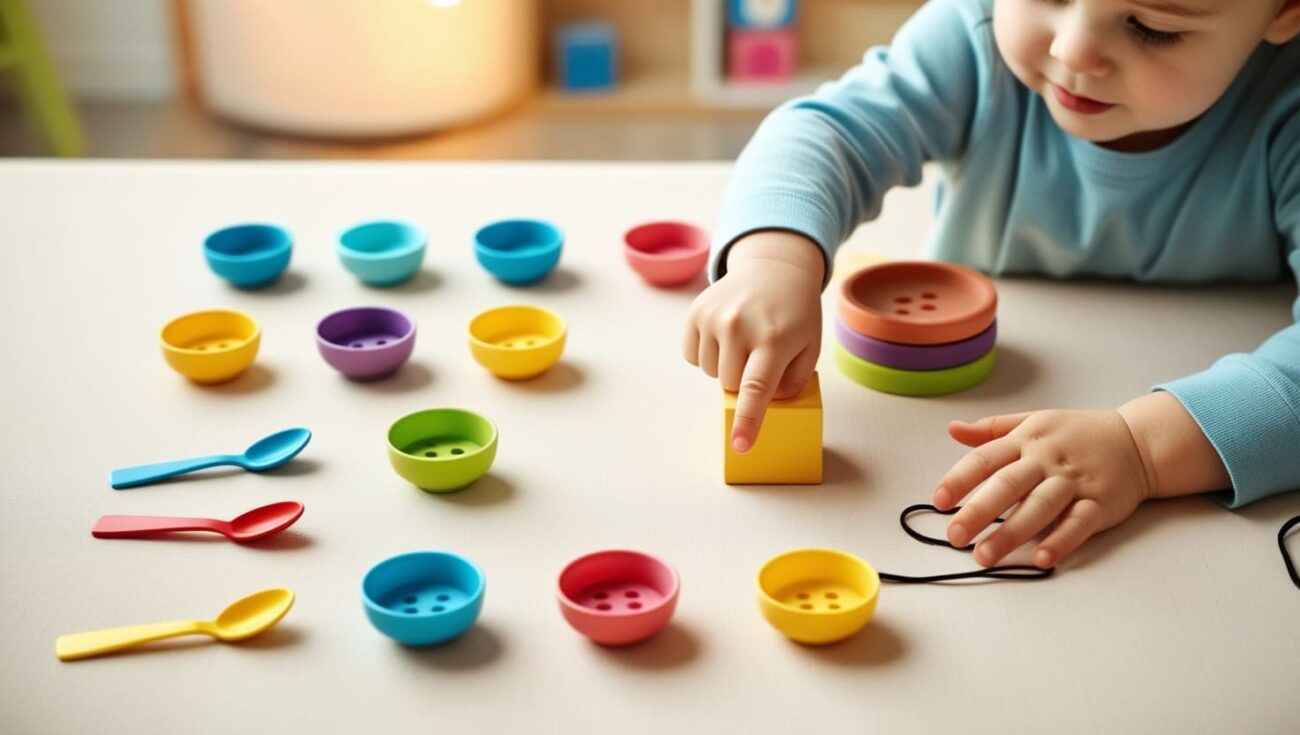Posts by sindbad
02
May
How to Teach Your Child the Concept of Time Easily
Do you find it difficult to explain time to your child? Concepts like later, in five minutes, or tomorrow can be surprisingly abstract for young minds. That’s because children perceive time differently—they live in the moment, and the passage of time isn’t something they can easily see or measure.
But don’t worry. With a mix of consistency, visual aids, and relatable daily routines, you can help your child grasp the concept of time in a way that feels simple and concrete. In this article, we’ll share five effective, hands-on methods to teach your child time using tools you already have at home.
Tip 1: Use Daily Routines to Represent Time
Children thrive on routine—and routine is one of the best ways to introduce the passage of time.
Break the Day into Parts: Use natural markers like morning, afternoon, evening, and night. Say things like,...
02
May
How to Teach Your Child to Count Using Simple Tools
Are you searching for fun, simple, and practical ways to teach your child how to count? Counting is one of the first core mathematical skills children encounter, and it lays the groundwork for number sense, addition, subtraction, and more advanced math concepts later in school.
The best part? You don’t need to invest in expensive educational toys or high-tech apps. Teaching your child to count can be done using everyday household items, creative play, and daily routines. Through simple, consistent practice in a playful environment, your child can learn to recognize numbers, understand quantities, and build a solid foundation for lifelong math success. In this article, we’ll explore five easy and engaging ways to teach your child to count using tools you already have at home.
Tip 1: Use Everyday Household Items
Your home is full of free and...
02
May
How to Strengthen Your Child’s Visual Memory
Does your child often forget where they placed their toys, or struggle to remember details of what they just saw in a book or a picture? These are common signs that your child’s visual memory might need strengthening. Visual memory refers to the brain’s ability to process, store, and recall visual information—an essential skill for early learning, especially when it comes to reading, writing, spelling, and problem-solving.
A strong visual memory allows children to remember letters, shapes, numbers, and the order of images in a sequence. It plays a vital role in helping them recognize patterns, follow directions, and stay organized. The good news is that visual memory is a skill that can be improved through regular, playful practice.
In this article, we’ll explore five proven and enjoyable ways to strengthen your child’s visual memory using interactive games, drawing activities, observation challenges, and story-based recall....
02
May
How to Teach Your Child to Sort Shapes and Colors
Is your child ready to learn how to sort shapes and colors? Sorting is one of the most important cognitive skills that children begin to develop in early childhood. It forms the foundation for more advanced thinking skills, including categorization, comparison, and problem-solving. When children learn to sort by color and shape, they begin to understand how to observe, differentiate, and classify the world around them.
Learning how to sort shapes and colors also supports the development of early math and science skills. Children learn to recognize similarities and differences, organize objects based on specific features, and build the mental flexibility needed for future academic success.
In this article, we’ll explore fun, simple, and effective ways to teach your child to sort shapes and colors at home. From games and toys to daily routines and songs, you’ll...
02
May
How to Help Your Child Recognize Numbers in a Fun Way
Is your child struggling to recognize numbers? Don’t worry—you’re not alone. Number recognition is a foundational step in early childhood education, setting the stage for all future math learning. But teaching your child to recognize numbers doesn’t have to feel like a chore. In fact, with the right activities and attitude, it can be fun, interactive, and something you both look forward to.
In this article, we’ll explore fun and effective ways to help your child recognize numbers. These creative strategies include games, songs, books, and simple daily routines that naturally reinforce number learning. By turning learning into play, you help your child build confidence in their abilities and lay the groundwork for strong numeracy skills.
Tip 1: Use Interactive Games
Why this works: Children learn best through hands-on play. Interactive games keep them engaged and excited about...
02
May
How to Teach Your Child the Alphabet in a Fun Way
Is your child struggling to learn the alphabet? You're not alone. Teaching the alphabet is one of the most essential steps in early childhood education. It lays the foundation for reading, writing, and overall literacy development. But the good news is: learning the ABCs doesn’t have to be boring or difficult. In fact, it can be a fun, exciting, and memorable experience for both you and your child.
In this article, we’ll explore creative and engaging methods to teach your child the alphabet in a fun way, including interactive games, crafts, songs, and daily routines. These playful strategies will not only improve alphabet recognition but also build a strong emotional bond with your child during the learning process.
Tip 1: Use Alphabet Games
Why it helps:Children learn best through play. Alphabet games make the learning process feel less like...
01
May
Why Bedtime Stories Matter and How to Choose
Do bedtime stories really make a difference?Absolutely. Reading to your child at night is more than just a sweet tradition — it's a powerful bonding tool that supports emotional well-being, cognitive development, and restful sleep. In this article, we explore why bedtime stories matter, how to pick the right one, and how to turn your nightly routine into a cherished ritual.
1. Why Bedtime Stories Are So Important
Bedtime stories aren’t just for fun — they help children grow in essential ways:
Language Development: Regular reading exposes children to new words and sentence structures, helping expand their vocabulary and improve communication skills.
Imagination and Creativity: Stories open doors to new worlds and encourage creative thinking and problem-solving.
Improved Focus: Listening to stories improves attention span and the ability to follow sequences — skills that benefit learning later on.
Teaching Life Lessons: Many children’s stories explore...
01
May
Co-Sleeping with Your Child: Pros, Cons, and When to Stop
Is your child still sleeping in your bed? You’re not alone. Co-sleeping — the practice of parents and children sharing the same sleeping space — is deeply rooted in many cultures and family traditions. While it can foster closeness and comfort, it also brings questions about independence, sleep quality, and when to transition your child to their own bed.
In this article, we explore the benefits, emotional impact, challenges, and safe practices of co-sleeping — and how to know when it’s time to make a gentle shift toward solo sleep.
1. The Benefits of Co-Sleeping for Parent and Child
When done mindfully, co-sleeping can nurture both emotional connection and practical ease.
Why families choose to co-sleep:
Stronger Bonding: The physical closeness strengthens emotional ties and helps the child feel more secure.
Easier Nighttime Feedings: Especially for breastfeeding moms, nighttime becomes less disruptive.
Peace of Mind: Having your child nearby can ease parental anxiety and...
01
May
How to Handle Bedtime Crying: Calm and Effective Ways to Cope
Does your child often cry when it’s time to sleep? Bedtime crying is a common challenge that many parents face, especially with toddlers and preschoolers. Whether the cause is separation anxiety, fear, overstimulation, or simple resistance to sleep—understanding the root and responding calmly can make all the difference.
In this article, we’ll explore gentle, effective strategies that help turn tearful nights into peaceful ones, while strengthening your child’s sense of safety and trust.
1. Understand the Root Cause of the Crying
Before reacting, it’s important to consider why your child is crying at bedtime. When you understand the underlying need, you can respond with empathy and practical solutions.
Common Causes of Bedtime Crying:
Separation Anxiety: Especially in children ages 6 months to 3 years.
Overtired or Overstimulated: Too much activity or skipping naps may leave them restless.
Hunger or Thirst: A light, healthy bedtime snack can help.
Fear of the Dark: Try a...
01
May
How to Create the Perfect Sleep Environment for Your Child
Does your child struggle with falling asleep or staying asleep through the night? While routines and nutrition play a big role, the sleep environment itself can be a game-changer. From lighting and temperature to comfort and noise levels, each detail affects how easily your child drifts off—and how well they sleep.
In this article, we’ll explore five key elements to creating the perfect sleep space for your child, so bedtime becomes a peaceful and effective part of your family’s routine.
1. Adjust the Lighting for a Calming Atmosphere
Lighting has a powerful effect on the brain’s ability to wind down for sleep. The wrong type of light can confuse your child’s body clock, while the right lighting helps signal: it’s time to rest.
Tips for Sleep-Friendly Lighting:
Use Warm, Dim Lights: Choose soft bedside lamps or nightlights with warm tones.
Avoid Overhead Brightness: Bright white lights can...




















